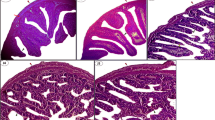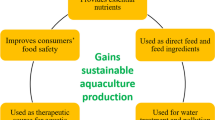Abstract
Understanding fish larval development is of a great interest for aquaculture production efficiency. Identifying possible indicators of fish larvae stress could improve the production and limit the mortality rate that larval stage is subjected to. Heat-shock proteins (HSPs) and heat-shock factors (HSFs) are well known as indicators of response to many kinds of stressor (e.g., environmental, morphological, or pathological changes). In this study, golden pompano larvae were raised at different temperatures (23 °C, 26 °C, and 29 °C), as well as three different diets (Artemia nauplii unenriched, Artemia nauplii enriched with Nannochloropsis sp., and Artemia nauplii enriched with Algamac 3080), and the expression of HSP60, HSP70, HSF1, HSP2, and GRP94 were monitored. While stress genes were widely expressed in the larval tissues, HSP60 and HSP70 were principally from the gills and heart; HSF1 principally from the muscle, brain, and heart; and GRP94 principally from the head kidney and spleen. Golden pompano larvae were found to be more sensitive to thermal changes at later larval stage, and 29 °C was showed to likely be the best condition for golden pompano larval development. Nannochloropsis sp.–enriched Artemia nauplii treatment was found to be the most appropriate feed type with moderate relative expressions of HSP60, HSP70, HSF1, HSF2, and GRP94.





Similar content being viewed by others
References
Barat A, Sahoo PK, Kumar R, Goel C, Singh AK (2016) Transcriptional response to heat shock in liver of snow trout (Schizothorax richardsonii)—a vulnerable Himalayan Cyprinid fish. Funct Integr Genomics 16:203–213
Barton BA, Iwama GK (1991) Physiological changes in fish from stress in aquaculture with emphasis on the response and effects of corticosteroids. Annu Rev Fish Dis 1:3–26
Buckley BA, Gracey AY, Somero GN (2006) The cellular response to heat stress in the goby Gillichthys mirabilis: a cDNA microarray and protein-level analysis. J Exp Biol 209:2660–2677
Cara JB, Aluru N, Moyano FJ, Vijayan MM (2005) Food-deprivation induces HSP70 and HSP90 protein expression in larval gilthead sea bream and rainbow trout. Comp Biochem Physiol B Biochem Mol Biol 142:426–431
Cheng P, Liu X, Zhang G, He J (2007) Cloning and expression analysis of a HSP70 gene from Pacific abalone (Haliotis discus hannai). Fish Shellfish Immunol 22:77–87
Das P, Gupta A, Manna SK (2015) Heat shock protein 70 expression in different tissues of Cirrhinus mrigala (Ham.) following heat stress. Aquac Res 36:525–529
Geven EJ, Klaren PH (2016) The teleost head kidney: Integrating thyroid and immune signalling. Dev Comp Immunol 66:73–83
Giri SS, Sen SS, Jun JW, Sukumaran V, Park SC (2016) Immunotoxicological effects of cadmium on Labeo rohita, with emphasis on the expression of HSP genes. Fish Shellfish Immunol 54:164–171
Govoni JJ, Boehlert GW, Watanabe Y (1986) The physiology of digestion in fish larvae. Environ Biol Fish 16:59–77
Guo H, Ma Z, Jiang S, Zhang D, Zhang N, Li Y (2014) Length-weight relationship of oval pompano, Trachinotus ovatus (Linnaeus 1758) (Pisces: Carangidae) cultured in open sea floating sea cages in South China Sea. Indian J Fish 61:93–95
Hekimoglu MA, Süzer C, Kop A, Saka S, Fırat K (2014) Comparison of ontogenic development and digestive enzymes in ornamental goldfish (Carassius auratus auratus L.) larvae fed with decapsulated cysts and nauplii of artemia Pakistan. J Zool 46:669–676
Hong J, Mao Y, Niu S, Sun T, Su Y (2015) Molecular characterization and expression of HSP70, HSF and HSBP genes in Octopus vulgaris during thermal stress 海洋学报(英文版). 34:62–72
Huck JD, Que NL, Hong F, Li Z, Gewirth DT (2017) Structural and functional analysis of GRP94 in the closed state reveals an essential role for the pre-N domain and a potential client-binding site. Cell Rep 20:2800–2809
Iwama GK, Thomas PT, Forsyth RB, Vijayan MM (1998) Heat shock protein expression in fish. Rev Fish Biol Fish 8:35–56
Kim SS, Chang Z, Park JS (2015) Identification, tissue distribution and characterization of two heat shock factors (HSFs) in goldfish (Carassius auratus ). Fish Shellfish Immunol 43:375–386
Korajoki H, Vornanen M (2014) Species- and chamber-specific responses of 12 kDa FK506-binding protein to temperature in fish heart. Fish Physiol Biochem 40:539–549
Lindquist S (1986) The heat-shock response. Annu Rev Biochem 55:1151–1191
Liu J, Yang WJ, Zhu XJ, Karounarenier NK, Rao RK (2004) Molecular cloning and expression of two HSP70 genes in the prawn, Macrobrachium rosenbergii. Cell Stress Chaperones 9:313–323
Ma Z, Guo H, Zheng P, Wang L, Jiang S, Qin JG, Zhang D (2014) Ontogenetic development of digestive functionality in golden pompano Trachinotus ovatus (Linnaeus 1758). Fish Physiol Biochem 40:1157–1167
Ma Z, Hu J, Liu Y, Yang R, Qin JG, Sun D (2016) Molecular cloning and response to water temperature and nutrient manipulation of insulin-like growth factor (IGF) genes in golden pompano Trachinotus ovatus (Linnaeus 1758) larvae. Isr J Aquacult- Bamid, IJA_68.2016.1336:14 pages
Ma Z, Hu J, Yu G, Qin JG (2018) Gene expression of bone morphogenetic proteins and jaw malformation in golden pompano Trachinotus ovatus larvae in different feeding regimes. J Appl Anim Res 46:164–177
Manos-Turvey A, Brodsky JL, Wipf P (2015) The effect of structure and mechanism of the Hsp70 chaperone on the ability to identify chemical modulators and therapeutics. 1–49
Matranga V, Toia G, Bonaventura R, Müller WE (2000) Cellular and biochemical responses to environmental and experimentally induced stress in sea urchin coelomocytes. Cell Stress Chaperones 5:113–120
Multhoff G, Pockley AG, Schmid TE, Schilling D (2015) The role of heat shock protein 70 (Hsp70) in radiation-induced immunomodulation. Cancer Lett 368:179–184
Nakai A (2016) Heat shock factor. Springer
Nie H, Liu L, Huo Z, Chen P, Ding J, Yang F, Yan X (2017) The HSP70 gene expression responses to thermal and salinity stress in wild and cultivated Manila clam Ruditapes philippinarum. Aquaculture 470:149–156
Niu J, Du Q, Lin HZ, Cheng YQ, Huang Z, Wang Y, Wang J, Chen YF (2013) Quantitative dietary methionine requirement of juvenile golden pompano Trachinotus ovatus at a constant dietary cystine level. Aquac Nutr 19:677–686
Ooi FK, Prahlad V (2017) Olfactory experience primes the heat shock transcription factor HSF-1 to enhance the expression of molecular chaperones in C. elegans. Sci Signal 10:eaan4893
Papetti C, Harms L, Windisch HS, Frickenhaus S, Sandersfeld T, Jürgens J, Koschnick N, Knust R, Pörtner HO, Lucassen M (2015) A first insight into the spleen transcriptome of the notothenioid fish Lepidonotothen nudifrons: resource description and functional overview. Mar Genomics 24:237–239
Parsell DA, Lindquist S (1993) The function of heat-shock proteins in stress tolerance: degradation and reactivation of damaged proteins. Annu Rev Genet 27:437–496
Pirkkala L, Nykänen P, Sistonen L (2001) Roles of the heat shock transcription factors in regulation of the heat shock response and beyond. FASEB J 15:1118–1131
Rabindran SK, Haroun RI, Clos J, Wisniewski J, Wu C (1993) Regulation of heat shock factor trimer formation: role of a conserved leucine zipper. Science 259:230–234
Ransangan J, Manin BO, Abdullah A, Roli Z, Sharudin EF (2011) Betanodavirus infection in golden pompano, Trachinotus blochii, fingerlings cultured in deep-sea cage culture facility in Langkawi, Malaysia. Aquaculture 315:327–334
Rebl A, Brietzke A, Goldammer T, Seyfert HM (2014) GRP94 is encoded by two differentially expressed genes during development of rainbow trout (Oncorhynchus mykiss). Fish Physiol Biochem 40:1917–1926
Roberts RJ, Agius C, Saliba C, Bossier P, Sung YY (2010) Heat shock proteins (chaperones) in fish and shellfish and their potential role in relation to fish health: a review. J Fish Dis 33:789–801
Rønnestad I, Yúfera M, Ueberschär B, Ribeiro L, Sæle Ø, Boglione C (2013) Feeding behaviour and digestive physiology in larval fish: current knowledge, and gaps and bottlenecks in research. Rev Aquac 5:S59–S98
Sagstad A, Sanden M, Haugland Ø, Hansen AC, Olsvik PA, Hemre GI (2007) Evaluation of stress- and immune-response biomarkers in Atlantic salmon, Salmo salar L., fed different levels of genetically modified maize (Bt maize), compared with its near-isogenic parental line and a commercial suprex maize. J Fish Dis 30:201–212
Schreck CB, Tort L (2016) The concept of stress in fish. In: Fish Physiology, vol 35. Elsevier, p 1–34
Sfakianakis DG, Renieri E, Kentouri M, Tsatsakis AM (2015) Effect of heavy metals on fish larvae deformities: a review. Environ Res 137:246–255
Shabtay A, Arad Z (2006) Reciprocal activation of HSF1 and HSF3 in brain and blood tissues: is redundancy developmentally related? Am J Physiol Regul Integr Comp Physiol 291:R566–R572
Shi HN, Liu Z, Zhang JP, Kang YJ, Wang JF, Huang JQ, Wang WM (2015) Short communication: effect of heat stress on heat-shock protein (Hsp60) mRNA expression in rainbow trout Oncorhynchus mykiss. Genet Mol Res 14:5280–5286
Skugor S, Grisdale-Helland B, Refstie S, Afanasyev S, Vielma J, Krasnov A (2011) Gene expression responses to restricted feeding and extracted soybean meal in Atlantic salmon (Salmo salar L.). Aquac Nutr 17:505–517
Sun X et al (2016) Feed type regulates the fatty acid profiles of golden pompano Trachinotus ovatus (Linnaeus 1758). J Appl Anim Res 1–4
Tateishi Y, Ariyoshi M, Igarashi R, Hara H, Mizuguchi K, Seto A, Nakai A, Kokubo T, Tochio H, Shirakawa M (2009) Molecular basis for SUMOylation-dependent regulation of DNA binding activity of heat shock factor 2. J Biol Chem 284:2435–2447
Tutman P, Glavic N, Kozul V, Skaramuca B, Glamuzina B (2004) Preliminary information on feeding and growth of pompano, Trachinotus ovatus (Linnaeus, 1758) (Pisces; Carangidae) in captivity. Aquac Int 12:387–393
Urán PA, Schrama JW, Rombout JHWM, Taverne-Thiele JJ, Obach A, Koppe W, Verreth JAJ (2009) Time-related changes of the intestinal morphology of Atlantic salmon, Salmo salar L., at two different soybean meal inclusion levels. J Fish Dis 32:733–744
Wang Y, Xu J, Sheng L, Zheng Y (2007) Field and laboratory investigations of the thermal influence on tissue-specific Hsp70 levels in common carp (Cyprinus carpio). Comp Biochem Physiol A Mol Integr Physiol 148:821–827
Wang T-Y, Chen Y-M, Chen T-Y (2016) Molecular cloning of orange-spotted grouper (Epinephelus coioides) heat shock transcription factor 1 isoforms and characterization of their expressions in response to nodavirus. Fish Shellfish Immunol 59:123–136
Werner I, Viant MR, Rosenblum ES, Gantner AS, Tjeerdema RS, Johnson ML (2006) Cellular responses to temperature stress in steelhead trout (onchorynchus mykiss) parr with different rearing histories. Fish Physiology & Biochemistry 32(3):261–273
Werner I, Nagel R (2010) Stress proteins HSP60 and HSP70 in three species of amphipods exposed to cadmium, diazinon, dieldrin and fluoranthene. Environ Toxicol Chem 16:2393–2403
Werner I, Linares-Casenave J, Eenennaam JPV, Doroshov SI (2007) The effect of temperature stress on development and heat-shock protein expression in larval green sturgeon ( Acipenser mirostris ). Environ Biol Fish 79:191–200
Xu XY, Shen YB, Fu JJ, Liu F, Guo SZ, Yang XM, Li JL (2011) Molecular cloning, characterization and expression patterns of HSP60 in the grass carp (Ctenopharyngodon idella). Fish Shellfish Immunol 31:864–870
Yang Y, Li Z (2005) Roles of heat shock protein gp96 in the ER quality control: redundant or unique function? Mol Cells 20:173
Yang Q, Zheng P, Ma Z, Li T, Jiang S, Qin JG (2015) Molecular cloning and expression analysis of the retinoid X receptor (RXR) gene in golden pompano Trachinotus ovatus fed Artemia nauplii with different enrichments. Fish Physiol Biochem 41:1449–1461. https://doi.org/10.1007/s10695-015-0098-x
Yeh FL, Hsu LY, Lin BA, Chen CF, Li IC, Tsai SH, Hsu T (2006) Cloning of zebrafish (Danio rerio) heat shock factor 2 (HSF2) and similar patterns of HSF2 and HSF1 mRNA expression in brain tissues. Biochimie 88:1983–1988
Zhu G, Lee AS (2015) Role of the unfolded protein response, GRP78 and GRP94 in organ homeostasis. J Cell Physiol 230:1413–1420
Funding
This project was supported by the National Natural Science Foundation of China (31502186), Pearl River S&T Nova Program of Guangzhou (201610010166), and Ministry of Human Resources and Social Security of China (2016 High-level Overseas Researcher Come Back to Work Funds).
Author information
Authors and Affiliations
Corresponding author
Ethics declarations
The Trachinotus ovatus is not endangered or protected species, and there is no requirement for permission to perform experiments involving this species in China.
Rights and permissions
About this article
Cite this article
Allais, L., Zhao, C., Fu, M. et al. Nutrition and water temperature regulate the expression of heat-shock proteins in golden pompano larvae (Trachinotus ovata, Limmaeus 1758). Fish Physiol Biochem 45, 485–497 (2019). https://doi.org/10.1007/s10695-018-0578-x
Received:
Accepted:
Published:
Issue Date:
DOI: https://doi.org/10.1007/s10695-018-0578-x




